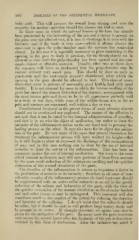Page 936 - My FlipBook
P. 936
946 DISEASES OF THE PERIDENTAL MEMBRANE.
bolic acid. This will prevent the wound from closing and save the
necessity for another operation should the abscess not heal at once.
In those cases in which the external lamina of the bone has already
been penetrated by the burrowing of the pus and a tumor is present on
the gum over the aifected root, it is best to discharge it at once with the
bistourv, and if the tooth is very sore—which is almost always the
case—not to open the pulp-chamber until the soreness has somewhat
abated. In this case it is especially necessary to place something in the
opening in the gum to keep it patulous, for the fistula should not be
allowed to close until the pulp-chamber has been opened and the root-
canals cleared of offensive material. Usually, after two or three days
the soreness will have so moderated that the pulp-chamber may be
entered without very much pain. This should be done as early as
practicable and the root-canals properly disinfected, after which the
opening in the gum should be allowed to heal. This class of cases,
when they occur in patients of reasonably good health, heal with great
facility. It is not unusual for cases in which the intense swelling of the
parts has caused the utmost distortion of the features, accompanied with
the most intense pain and fever, to be to all appearance perfectly well
in a week or ten days, while some of the milder forms are, so far as
pain and soreness are concerned, well within a day or two.
Constitutional treatment in the graver forms of acute alv^eolar abscess
should not be overlooked nor neglected. The nature of the affection is
not such that it can be cured by the internal administration of remedies,
and that is in no wise the object of medication, but rather to limit the
intensity of the inflammatory action on the one hand and to promote the
healing process on the other. It may also have for its object the mitiga-
tion of the pain. In very many of the cases that present themselves for
treatment the inflammatory process will have reached its heiglit—that
is, it will begin to abate at once—on the discharge of the accumulation
of pus ; and in this case nothing can be done by the use of internal
remedies to limit the extent of the inflammation. This has been an
argument against the use of internal medication. But even in the cases
stated internal medication may still save portions of bone from necrosis
by the more ready reduction of the oedematous swelling and the quicker
restoration of the normal circulation of the parts.
The duration of the inflammation is almost as important a factor in
the production of necrosis as its intensity ; therefore in all cases of con-
siderable severity of the inflammatory process the local treatment should
be supplemented with an active saline cathartic as an aid in the speedy
reduction of the oedema and induration of the parts, wdth the view of
the quicker restoration of the normal circulation to the alveolar borders
and such other tissues as may be endangered. This treatment will also
contribute much to the comfort of the patient by reducing the duration
and intensity of the suffering. I do not insist that the cathartic should
be saline, but it should be such as will produce large watery stools and
be prompt in its action. If thought necessary, an opiate may also be
given for the mitigation of the pain. In many cases the pain continues
very severe for several hours after the discharge of the pus unless coun-
teracted by this form of medication. After the cathartic has acted it


